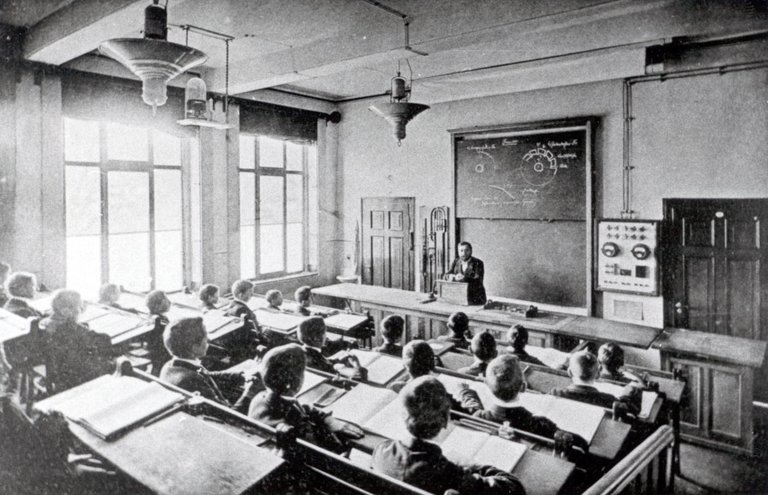The history of the University of Applied Sciences Schmalkalden dates back to the year 1902 when, on 1 July, the “Royal Technical College for Iron and Steel Industry Schmalkalden" was established.
For centuries, the people in the region around Schmalkalden had been making their living from the manufacture of all kinds of ironware goods such as awls, files, curry combs, drills, pliers, spoons, nails, buckles, and so on, which even today are known as “Schmalkalden goods”. However, these goods, manufactured in small businesses, now faced industrial competition from Rhineland-Westphalian factories and from overseas which they weren’t able to withstand.
If an improvement to the economic situation was to be achieved, the production process had to be modernised and the workers better trained. In 1893, the Schmalkalden Administrative Officer, Dr. Hagen, suggested to the Prussian Minister for Commerce and Trade to establish a Technical College similar to the one in Remscheid.
Right from the beginning the college did not only regard itself as a training centre for craftsmen, but also offered businesses of the region a large variety of training programmes and its teachers were available for technical, technological and commercial consultancy.
Each teacher worked several weeks per year in one of the leading German businesses in order to familiarise himself with modern plants, machines, facilities and procedures. All of this helped to guarantee a training conform to the standards of that time.
The first college director Emil Beil
The engineer Emil Beil was the first college director and held this position for twenty-seven years. It was not least due to him that the college quickly acquired a good reputation even beyond the Prussian borders. The student directories and the school inspectorate files give clear evidence for this.
The college also achieved international recognition. Even before the First World War visitors came from various European countries, the USA and China, in order to take a look at what was going on here. The new institution contributed to the economic improvement especially through the intensive advisory services to Schmalkalden businesses.
After the Weimar Republic was formed in 1918, the college continued its work as “State Technical College for Iron and Steel Industry Schmalkalden" without any change to its duties. As from 1920, master classes complemented the training programme. A new development stage began after the Second World War as the escalating demand for technical engineers could not be met by the training capacities at engineering schools.
Technician training in Schmalkalden commenced in the autumn of 1945. By order of the Thuringian Ministry of Education, the college was converted to a School of Mechanical Engineering in 1948. In the spring of 1951, the first engineers who had trained in Schmalkalden received their certificates. From then on, the number of students increased continuously.
In the course of the following 45 years up to the termination of training at this “School of Engineering Schmalkalden” in 1995, more than 10,000 young people received their engineer’s diploma. Students came from all parts of the then German Democratic Republic, from the Baltic Sea to the Lausitz (Lusatia) area. The quality of their training contributed substantially to the fact that mechanical engineers from Schmalkalden enjoyed an excellent reputation everywhere. Up to the construction of the Berlin Wall this reputation extended into the western part of our fatherland so that in the 1950s job offers for engineers appeared occasionally in West German trade journals stating that applications from graduates of the School of Engineering Schmalkalden would be given preference.
Campus university
On 1 October 1991, with the founding of the University of Applied Sciences, began for Schmalkalden a new milestone in the history of higher education. Mechanical engineering remained one of the pillars in the university’s study programme and others were added. The Faculty of Electrical Engineering was established in the founding year, offering a programme with the same name. The following year the Faculty of Computer Science and the Faculty of Business and Economics followed suit, and in so doing the first steps towards establishing a modern university with both technical and business orientation had been taken.
However, it soon became clear that an efficient, modern university in Schmalkalden could only be sustained through the construction of new buildings. With the active support of the city of Schmalkalden and the local authorities the required grounds could be secured in the following years.
On the site of the old Prussian college a plot was purchased that enabled the construction of a single-campus university. In the autumn of 2000, the first single-campus university in Thuringia opened which included a central lecture building with three large lecture halls and numerous seminar rooms as well as a library - a light-flooded, glass building with separate, water-surrounded, outdoor “reading island”.
The Faculties of Mechanical Engineering and Electrical Engineering have new, modern laboratory buildings and the Faculty of Computer Science is now in a new building. The cafeteria also boasts a modern design. The university’s buildings immediately catch the eye: they are alive with positive energy flowing between historical structure and modern architecture.

